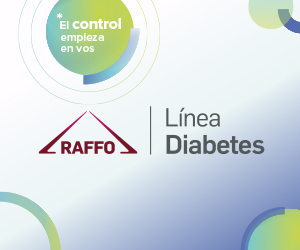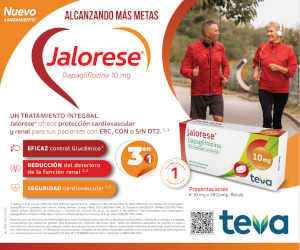Fasting blood glucose between 100 and 109 mg/dL versus prediabetes according to glycosylated hemoglobin
DOI:
https://doi.org/10.47196/diab.v56i2.521Keywords:
prediabetes, HbA1c, glycosylated hemoglobin, fasting blood glucose, normal blood glucoseAbstract
Introduction: some studies have shown that fasting blood glucose values between 100 and 109 mg/dL are associated with high rates of prediabetes when the classification criteria are HbA1c values. The Argentine Diabetes Society still maintains 110 mg/dL as the value from which a patient is classified as having impaired fasting blood glucose; the frequency of individuals possibly incorrectly classified, according to this criterion, is not yet known in any Argentine population.
Objectives: to establish the frequency in a population without a diagnosis of diabetes mellitus with fasting blood glucose levels between 100 and 109 mg/dL in which prediabetes occurs according to HbA1c, to correlate both variables and to quantify the probability that this predicts with respect to others with fasting blood glucose levels <100 mg/dL.
Materials and methods: 1.002 samples from the same number of subjects from 45 clinical laboratories belonging to ALAC, with local processing of blood glucose and centralized processing of HbA1c by high performance liquid chromatography (HPLC). Statistical analysis: chi square, odds ratio, Pearson correlation coefficient, coefficient of determination and Durbin-Watson serial correlation.
Results: frequency of HbA1c ≥5.7% in the studied population with fasting blood glucose levels between 100 and 109 mg/ dL = 29.7%, chi square test: p<0.001; odds ratio of having HbA1c ≥5.7% between the population with fasting blood glucose levels of 100 to 109 mg/dL vs that one with values <100 mg/dL=4.328 (95% CI 2.922-6.411); r=0.852, r2 =0.727, DurbinWatson=1.152.
Conclusions: prediabetes diagnosed by HbA1c was four times more frequent in the studied population with fasting glucose values between 100 and 109 mg/dL than in that one with values below 100 mg/dL.
References
I. Convergencias, divergencias, variabilidad, puntos de corte e indicación de la glucemia de ayuno, la hemoglobina glucosi- lada e insulinemia. Jornadas Rioplatenses. 24 y 25 de abril de 2010. Colonia, República Oriental del Uruguay.
II. Faerch K, Borch-Johnsen K, Holst JJ, Vaag A. Pathophysiolo- gy and aetiology of impaired fasting glycaemia and impaired glucose tolerance: does it matter for prevention and treatment of type 2 diabetes? Diabetologia 2009 Sep;52(9):1714-23. doi: 10.1007/s00125-009-1443-3. Epub 2009 Jul 10. PMID: 19590846.
III. American Diabetes Association Professional Practice Committee; American Diabetes Association Professional Practice Committee:; Draznin B, Aroda VR, Bakris G, Benson G, Brown FM, Freeman R, Green J, Huang E, Isaacs D, Kahan S, Leon J, Lyons SK, Peters AL, Prahalad P, Reusch JEB, Young-Hyman D, Das S, Kosiborod M. Classification and diagnosis of diabetes: Standards of medical care in diabetes-2022. Diabetes Care. 2022 Jan 1;45(Supplement_1):S17-S38. doi: 10.2337/dc22-S002. PMID: 34964875.
IV. Atlas de la Diabetes de la International Diabetes Federation (IDF). Novena Edición 2019.
V. Alberti KG, Zimmet PZ. De nition, diagnosis and classi cation of diabetes mellitus and its complications. Part 1: diagnosis and classi cation of diabetes mellitus provisional report of a WHO consultation. Diabet Med 1998 Jul;15(7):539-53. doi: 10.1002/ (SICI)1096-9136(199807)15:7<539:AID-DIA668>3.0.CO;2-S. PMID: 9686693.
VI. World Health Organization. Screening for type 2 diabetes. Re- port of a World Health Organization and International Diabetes Federation meeting. WHO/NMH/MNC/03.1 Geneva: WHO De- partment of Noncommunicable Disease Management. 2003
VII. Brannick B, Wynn A, Dagogo-Jack S. Prediabetes as a to- xic environment for the initiation of microvascular and ma- crovascular complications. Exp Biol Med (Maywood) 2016 Jun;241(12):1323-31. doi: 10.1177/1535370216654227. PMID: 27302176; PMCID: PMC4950274.
VIII. Lindström J, Tuomilehto J. The diabetes risk score: a practi- cal tool to predict type 2 diabetes risk. Diabetes Care 2003 Mar;26(3):725-31. doi: 10.2337/diacare.26.3.725. PMID: 12610029.
IX. Chaila MZ, Viniegra M, Gagliardino JJ, Martínez A, Simesen de Bielke MG, Frusti M, Monaco L, Salgado P, Buso C, Gonzalez CD, Commendatore VF. Glycated hemoglobin measurement: comparison of three methods versus high performance liquid Chromatography. J Diabetes SciTechnol 2021 Mar 9:1932296821997179. doi: 10.1177/1932296821997179. Epub ahead of print. PMID: 33686874.
X. American Diabetes Association. Standards of medical care in diabetes. Diabetes Care 2010;33 Suppl 1(Suppl 1):S11-S61. doi: 10.2337/dc10-S011.
XI. World Health Organization (2011). Use of glycated haemoglobin (HbA1c) in the diagnosis of diabetes mellitus. Abbreviated report of a WHO Consultation. WHO/NMH/CHP/CPM; 11. 1-25. Disponible en: https://apps.who.int/iris/bitstream/handle/10665/70523/ WHO_NMH_CHP_CPM_11.1_eng.pdf?sequence=1&isAllowed=y.
XII. Defronzo RA, Abdul-Ghani M. Assessment and treatment of car- diovascular risk in prediabetes: impaired glucose tolerance and impaired fasting glucose. The American Journal of Cardiology 2011;108(3Suppl):3B-24B. doi: 10.1016/j.amjcard.2011.03.013.
XIII. Gagliardino JJ, Salazar MR, EspecheWG,Tolosa-Chapasian PE, Gómez-Garizoain D, Olano RD, Stavile RM, Balbín E, Martínez C, Leiva-Sisnieguez BC, Leiva-Sisnieguez CE, Carbajal HA. Arterial stiffness: its relation with prediabetes and metabolic syndrome and possible pathogenesis. J Clin Med 2021;10:3251.
XIV. HermanWH,YeW,Grif nSJ,Simmons RK, Davies MJ, Khunti K, Rutten GEHM, Sandbaek A, Lauritzen T, Borch-Johnsen K, Brown MB and Wareham NJ. Early detection and treatment of type 2 diabetes reduce cardiovascular morbidity and mortality: a simulation of the results of the Anglo-Danish-Dutch Study of Intensive Treatment in people with screen-detected diabetes in primary care (ADDITION-Europe). Diabetes Care 2015;38:1449-1455.
Downloads
Published
How to Cite
Issue
Section
License
Copyright (c) 2022 on behalf of the authors. Reproduction rights: Argentine Diabetes Society

This work is licensed under a Creative Commons Attribution-NonCommercial-NoDerivatives 4.0 International License.
Dirección Nacional de Derecho de Autor, Exp. N° 5.333.129. Instituto Nacional de la Propiedad Industrial, Marca «Revista de la Sociedad Argentina de Diabetes - Asociación Civil» N° de concesión 2.605.405 y N° de disposición 1.404/13.
La Revista de la SAD está licenciada bajo Licencia Creative Commons Atribución – No Comercial – Sin Obra Derivada 4.0 Internacional.
Por otra parte, la Revista SAD permite que los autores mantengan los derechos de autor sin restricciones.


































